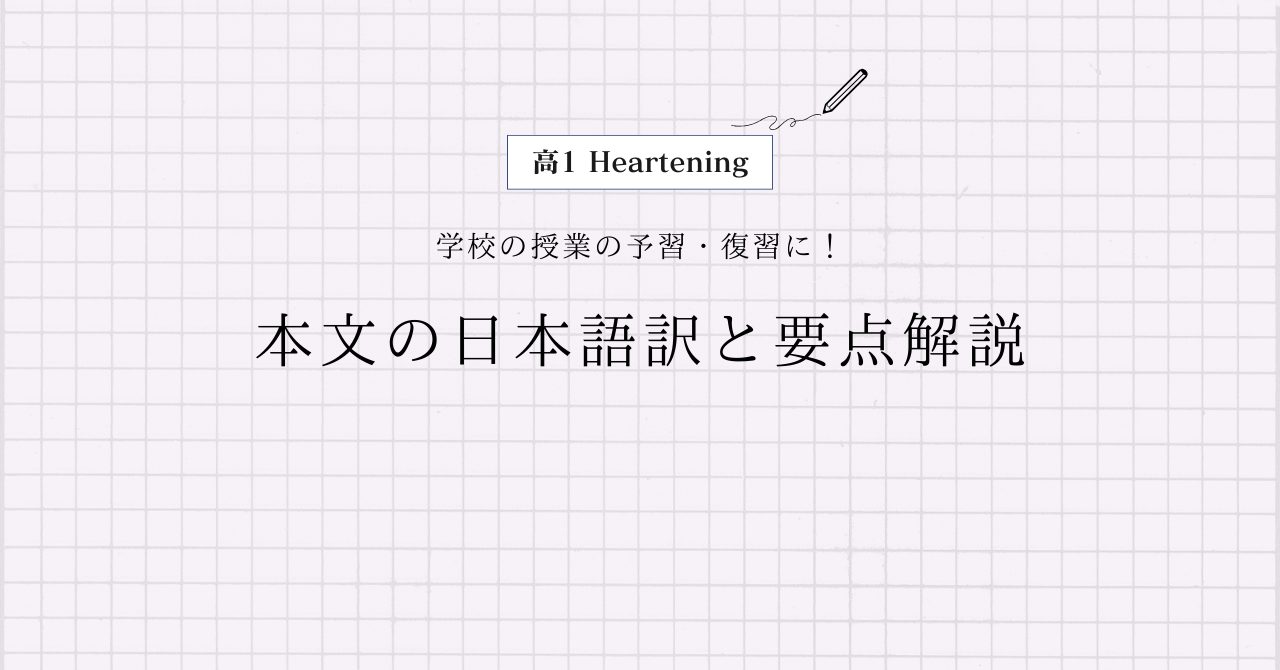桐原書店 高1Heartening Lesson5 Section3の本文の日本語訳と重要箇所の解説です。
Lesson5-1, 5-2, 5-4の解説はこちらからご覧ください。
>高1Heartening Lesson5 Section1 本文和訳
>高1Heartening Lesson5 Section2 本文和訳
>高1Heartening Lesson5 Section4 本文和訳
- Heartening Lesson5 Section3 本文と日本語訳
- Heartening Lesson5 Section3 重要事項の解説
- Orders for Akimoto’s canned bread started to come in from companies and local governments all over Japan.
- One day in 2004, there was a phone call from a city office that had bought the bread.
- “Our canned bread is nearing its best-before date,” the city official said, “so we want to purchase some more boxes, and we’d like you to dispose of our old stock.”
- Akimoto had a new challenge.
- He now needed to prevent his bread from going to waste.
- A few months later, a terrible tsunami struck Sri Lanka.
- Akimoto got a request from a friend in that country.
- “The people here have nothing to eat. So could you send us any leftover canned bread?”
- That gave Akimoto an idea.
- “Canned bread is sometimes thrown away in Japan as the best-before date approaches. But some people around the world need that bread right now,” he thought.
- “Let’s give the cans to them.”
- Heartening Lesson5 Section3 まとめ
Heartening Lesson5 Section3 本文と日本語訳
Orders for Akimoto’s canned bread started to come in from companies and local governments all over Japan.
「秋元さんの缶詰パンの注文は、日本中の会社や地方公共団体から入り始めました。」
One day in 2004, there was a phone call from a city office that had bought the bread.
「2004年のある日、そのパンを買った市役所から電話がありました。」
“Our canned bread is nearing its best-before date,” the city official said, “so we want to purchase some more boxes, and we’d like you to dispose of our old stock.”
「『私たちの缶詰パンが賞味期限が近付いているので、もういくつか箱で購入したいのと、古い在庫を処分してほしいです。』と市の職員が言いました。」
Akimoto had a new challenge.
「秋元さんは新たな課題を抱えました。」
He now needed to prevent his bread from going to waste.
「彼は今、パンが無駄になるのを防ぐ必要がありました。」
A few months later, a terrible tsunami struck Sri Lanka.
「数か月後、恐ろしい津波がスリランカを襲いました。」
Akimoto got a request from a friend in that country.
「秋元さんはその国の友人から依頼を受けました。」
“The people here have nothing to eat. So could you send us any leftover canned bread?”
『ここの人々は食べるものが何もないんだ。だから余った缶詰パンを送ってくれないか?』
That gave Akimoto an idea.
「そのことは秋元さんにあるアイディアを与えました。」
“Canned bread is sometimes thrown away in Japan as the best-before date approaches. But some people around the world need that bread right now,” he thought.
「『賞味期限が近づくにつれて、日本では缶詰パンは時に捨てられる。しかし世界中には今すぐそのパンを必要としている人もいる。』と彼は思いました。」
“Let’s give the cans to them.”
『彼らに缶詰をあげよう。』

Heartening Lesson5 Section3 重要事項の解説
Orders for Akimoto’s canned bread started to come in from companies and local governments all over Japan.
“order”は「注文」という名詞で、“order for~”で「~の注文」となります。
名詞に‘sを付けると「~の」という所有を表します。
直前の名詞が複数形のときは” teachers‘ “のようにアポストロフィーだけを最後に付けます。
“can”は「を缶詰にする」という動詞で、ここでは「過去分詞」として後ろの“bread”を修飾しています。
“come in from~”は「~から入る」という意味で、“to”が付いて「不定詞の名詞的用法」になっていますね。
“company”は「会社」、“local government“は「地方公共団体」という名詞です。
“all over~“は「~中」といった意味になります。
One day in 2004, there was a phone call from a city office that had bought the bread.
“one day”は「ある日」という意味ですね。また、「there構文」も使われています。
“phone call”は「電話」、“city office”は「市役所」という名詞です。
“that”は「主格の関係代名詞」で、“that had bought the bread”が先行詞“a city office”を修飾していますね。
“had bought”は「過去完了形」になっていて、ここでは「大過去」として、「パンの購入」→「電話」という時系列を明確にするために使われています。
“Our canned bread is nearing its best-before date,” the city official said, “so we want to purchase some more boxes, and we’d like you to dispose of our old stock.”
ここでは「現在進行形」になっていますね。
“near”は「に近づく」という動詞で、“best-before date”は「賞味期限」という名詞です。“its”は“Our canned bread”を指しています。
“city official”は「市の職員」となります。
“so”は「だから」という接続詞、“purchase”は「を購入する」という動詞、“some more”は「もう少し」という形容詞表現です。
“want to 動詞の原形”で「~したい」という重要表現です!「不定詞の名詞的用法」と一緒に確認しておきましょう。
“would like”は“want”と同じ「が欲しい」という意味で,“would like to 動詞の原形”で「~したい」という重要表現になります。
今回のように“would like 人 to 動詞の原形”だと「人に~してほしい」となりますね。
“dispose”は「処分する」という動詞で、“dispose of~”で「を処分する」という表現です。
“stock”は「在庫」という名詞ですね。
Akimoto had a new challenge.
“have a challenge”は「困難(課題)を抱える」という表現です。
He now needed to prevent his bread from going to waste.
“need”は「を必要とする」という動詞で、“to prevent”は「不定詞の名詞的用法」になっています。
“prevent”は「を防ぐ」という動詞で、“prevent A from B”で「AがBするのを防ぐ」という重要表現です。
“go to waste”は「無駄になる」という意味で、前置詞“from”の後ろなので“going”は「動名詞」になっていますね。
A few months later, a terrible tsunami struck Sri Lanka.
“a few”は「少しの」という意味で,後ろには可算名詞(数えられる名詞)が来ます。
“later”は「~後に、その後」といった副詞ですね。
“terrible”は「恐ろしい、ひどい」といった形容詞で、“struck”は“strike(を襲う、をぶつける)”の過去形、“Sri Lanka”は「スリランカ」です。
Akimoto got a request from a friend in that country.
“request”は「依頼、要求」という名詞です。
“that country”は“Sri Lanka“を指していますね。
“The people here have nothing to eat. So could you send us any leftover canned bread?”
“nothing”は「何も~ない」という代名詞で、“to eat”が「不定詞の形容詞的用法」として“nothing”を修飾していますね。
“could you~?”は「~していただけませんか?」という丁寧なお願いの表現です。
“send 人 もの”で「人にものを送る」となって,“send もの to 人”でも同じ意味になります。
“any”は疑問文で使うと「いくつかの」という“some”と同じ意味ですね。
“leftover”は「余った」という形容詞になります。
That gave Akimoto an idea.
“That”は直前の文を指していますね。
“give 人 もの”で「人にものをあげる」となって,“give もの to 人”でも同じ意味になります。
“Canned bread is sometimes thrown away in Japan as the best-before date approaches. But some people around the world need that bread right now,” he thought.
“sometimes”は「時々」という副詞です。
“throw away~”は「を捨てる」という重要表現で、ここでは「受動態」になっています。
“as”は「~するにつれて」という接続詞です。接続詞“as”は5つの意味があるので、文脈に応じて訳を考えないといけません。以下に“as”の意味をまとめておきます。
“approach”は「近づく、接近する」という動詞になります。
“around the world”は「世界中の」、“right now”は「今すぐ」という表現です。
“Let’s give the cans to them.”
“Let’s 動詞の原形”は「~しましょう」ですね。
同じ意味で“Shall we~?”や“Why don’t we~?”もあるのでセットで覚えましょう!
“can”は「缶詰」という名詞で、“them”は“some people around the world”を指していますね。
Heartening Lesson5 Section3 まとめ
以上がHeartening Lesson5 Section3の日本語訳となります。
>高1Heartening Lesson5 Section1 本文和訳
>高1Heartening Lesson5 Section2 本文和訳
>高1Heartening Lesson5 Section4 本文和訳
何か分からない点や他に解説してほしい点があれば,お気軽にコメントしてください!


コメント